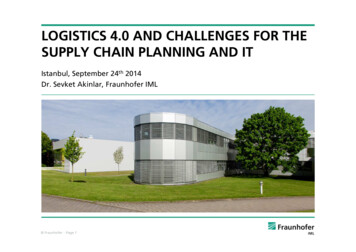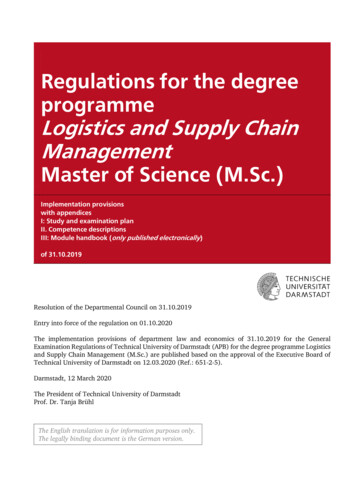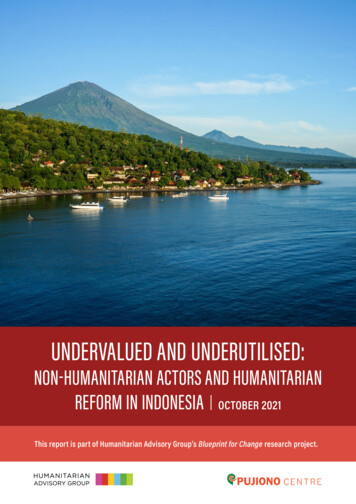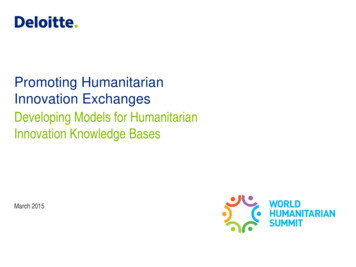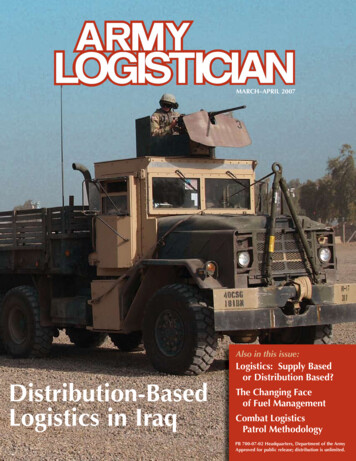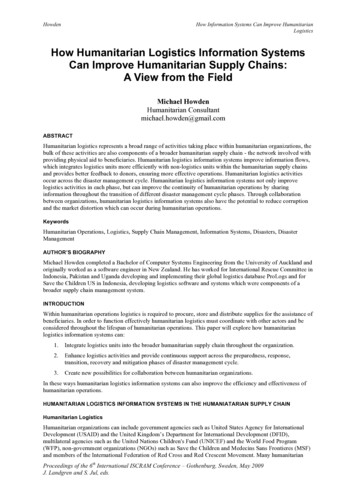
Transcription
HowdenHow Information Systems Can Improve HumanitarianLogisticsHow Humanitarian Logistics Information SystemsCan Improve Humanitarian Supply Chains:A View from the FieldMichael HowdenHumanitarian rian logistics represents a broad range of activities taking place within humanitarian organizations, thebulk of these activities are also components of a broader humanitarian supply chain - the network involved withproviding physical aid to beneficiaries. Humanitarian logistics information systems improve information flows,which integrates logistics units more efficiently with non-logistics units within the humanitarian supply chainsand provides better feedback to donors, ensuring more effective operations. Humanitarian logistics activitiesoccur across the disaster management cycle. Humanitarian logistics information systems not only improvelogistics activities in each phase, but can improve the continuity of humanitarian operations by sharinginformation throughout the transition of different disaster management cycle phases. Through collaborationbetween organizations, humanitarian logistics information systems also have the potential to reduce corruptionand the market distortion which can occur during humanitarian operations.KeywordsHumanitarian Operations, Logistics, Supply Chain Management, Information Systems, Disasters, DisasterManagementAUTHOR’S BIOGRAPHYMichael Howden completed a Bachelor of Computer Systems Engineering from the University of Auckland andoriginally worked as a software engineer in New Zealand. He has worked for International Rescue Committee inIndonesia, Pakistan and Uganda developing and implementing their global logistics database ProLogs and forSave the Children US in Indonesia, developing logistics software and systems which were components of abroader supply chain management system.INTRODUCTIONWithin humanitarian operations logistics is required to procure, store and distribute supplies for the assistance ofbeneficiaries. In order to function effectively humanitarian logistics must coordinate with other actors and beconsidered throughout the lifespan of humanitarian operations. This paper will explore how humanitarianlogistics information systems can:1.Integrate logistics units into the broader humanitarian supply chain throughout the organization.2.Enhance logistics activities and provide continuous support across the preparedness, response,transition, recovery and mitigation phases of disaster management cycle.3.Create new possibilities for collaboration between humanitarian organizations.In these ways humanitarian logistics information systems can also improve the efficiency and effectiveness ofhumanitarian operations.HUMANITARIAN LOGISTICS INFORMATION SYSTEMS IN THE HUMANIATARIAN SUPPLY CHAINHumanitarian LogisticsHumanitarian organizations can include government agencies such as United States Agency for InternationalDevelopment (USAID) and the United Kingdom’s Department for International Development (DFID),multilateral agencies such as the United Nations Children's Fund (UNICEF) and the World Food Program(WFP), non-government organizations (NGOs) such as Save the Children and Medecins Sans Frontieres (MSF)and members of the International Federation of Red Cross and Red Crescent Movement. Many humanitarianProceedings of the 6th International ISCRAM Conference – Gothenburg, Sweden, May 2009J. Landgren and S. Jul, eds.
HowdenHow Information Systems Can Improve HumanitarianLogisticsorganizations will engage in long term development activities as well as disaster management activitiessupporting people affected by disasters. This paper will only discuss humanitarian logistics as it is applied indisaster management.Humanitarian organizations usually include logistic units which can have different functions depending on theorganizations or even the disaster and can include: Procurement Warehousing Fleet Management Transportation (of both supplies and people) Asset Management Building Management Security Information Technology (IT) Radio CommunicationsHumanitarian operations consist of a diverse range of activities, therefore logistics in this context can have abroader scope than in the commercial sector. Areas such as security and IT may be considered under logisticsdue to respective military or technical experience of logisticians, either currently or historically within anorganization.Humanitarian Supply ChainsIn this paper a humanitarian supply chain refers to the network created through the flow of supplies, services,finances and information between donors, beneficiaries, suppliers and different units of humanitarianorganizations for the purpose of providing physical aid to beneficiaries (Mentzer et al. 2001). Humanitariansupply chains include functionalities which do not typically fall into the field of humanitarian logistics.Managing relationships with donors, performing needs assessments, planning for supplies required andmonitoring and evaluating the impact of distributed supplies, are usually the responsibility of non-logisticsprogram units. Figure 1 presents a summary of the major flows within both humanitarian supply chains andhumanitarian logistics.Proceedings of the 6th International ISCRAM Conference – Gothenburg, Sweden, May 2009J. Landgren and S. Jul, eds.
HowdenHow Information Systems Can Improve HumanitarianLogisticsFigure 1. Humanitarian Logistics and Humanitarian Supply Chain FlowsThis paper will focus on the value of information systems for logistic units of NGOs within the humanitariansupply chain.Integrating Logistics into Supply Chain ManagementWith the exception of organizations which specialize in disaster response or distribution, such as Medecins SansFrontieres (MSF) and World Food Program (WFP) respectively, the core business of humanitarian organizationstend towards health, education, protection and economic development. Logistics units are only considered as afunction to support these activities of humanitarian organizations. Logistics units have traditionally beenmarginalized within organizations (Rickard, 2003) and logisticians have been “pigeonholed” in the field,making it hard to move into management positions (Chaikin, 2003). This has contributed to a silo mentality inregards to logistics within humanitarian organizations. Better integrating logistics with other units within theorganization will form stronger humanitarian supply chains.In order to integrate logistics into broader humanitarian supply chains, a clear distinction is required between thetwo. In Indonesia, one major NGO moved all logistics functionality into a supply chain management unit. In theterms logistics and supply chain management are used interchangeably (Rickard, 2006) and personal discussionswith humanitarian professional have revealed the there is not a clear distinction between the terms logistics andsupply change management, and some have regarded any differences are semantics. In literature onhumanitarian organizations there is a shift from logistics to supply chain management (Thomas and Kopczak,2005) Humanitarian supply chains include units implementing programs, managing grants with donors,controlling budgets and monitoring activities which must coordinate with logistics units. Humanitarian supplychains cannot be built by solely increasing the capacity or responsibility of individual units, but are formed byProceedings of the 6th International ISCRAM Conference – Gothenburg, Sweden, May 2009J. Landgren and S. Jul, eds.
HowdenHow Information Systems Can Improve HumanitarianLogisticsthe creation of stronger links between units within the supply chain. Humanitarian logistics information systemscan improve the flow of information with other units, in a mutually constructive manner, improving theeffectiveness of the humanitarian supply chain.Humanitarian logistics information systems can: Enhance needs assessments by ensuring that field staff know what supplies are available forbeneficiaries, either in local warehouses, pre-positioned emergency stocks or from local andinternational markets. Share lists of supplies available in both local and international markets, including prices and lead times,logisticians to empower program staff to better plan their procurement activities. Keep program staff informed of procurement activities will help to develop an understanding of theconstraints within logistics and create trust. Provide budget holder more accurate financial information regarding funds which are committedwithin the procurement process, to avoid the over or under spending of budgets. Provide warehouse inventory reports to program staff to allow them to take more responsibility fortheir supplies, and ensure that they are utilized effectively. Share information on the distribution of supplies to allow program staff to better monitor and evaluateactivities and avoid the need for duplicate record keeping between logistics and programs. More accurately divide logistics overhead costs such as warehouse rental, transportation and logisticstaff wages into program budgets according to the activities logistics is supporting.Information empowers program units to become more engaged consumers of logistic services. In this wayinformation systems can integrate logistics into humanitarian supply chains and improve the effectiveness andefficiency of humanitarian operations. The improved information flow from humanitarian logistics informationsystems will also contribute to the overall effectiveness of the humanitarian operation.The Value of Information in the Humanitarian Supply ChainInformation plays a significant role in humanitarian supply chains. In humanitarian supply chains is that the endrecipient of aid (the beneficiary) is decoupled from the commercial transaction and has no direct influence overwhat supplies they receive (Gray and Oloruntob, 2006). The key decision makers within the humanitariansupply chain are the donors who are funding the operation and many NGOs regard the donor as the customer inthe humanitarian supply chain (Beamon and Balcik, 2006). In commercial supply chains, the end recipientdecides what supplies they require, and fulfillment can be easily evaluated by monitoring the receipt of thesesupplies. In humanitarian operations as supplies are determined by external assessments of the needs of thebeneficiary, evaluating fulfillment become more difficult, as additional analysis must be done to determine ifthese needs have been met by the supplies.Figure 2. Donors, Humanitarian Organizations and Beneficiaries within the Humanitarian Supply ChainHumanitarian logistics information systems can provide accurate and timely information on what supplies arerequired, what supplies have been delivered to beneficiaries and in which locations. With this informationProceedings of the 6th International ISCRAM Conference – Gothenburg, Sweden, May 2009J. Landgren and S. Jul, eds.
HowdenHow Information Systems Can Improve HumanitarianLogisticsevaluation units should be able to determine if those supplies have met the needs of the beneficiary. Thisfeedback ensures that donors and humanitarian organizations are engaged and responsive to the beneficiaries,and supporting aid according to the beneficiaries needs.HUMANITARIAN LOGISITCS IN THE DISASTER MANAGEMENT CYCLEResponse, Transition, Recovery, Mitigation and PreparednessThe operations of humanitarian organizations in disaster management can be separated into four major phases:response, recovery, mitigation and preparedness (Haddow and Bullock, 2004). During humanitarian operationsthere will be overlap between activities from different phases, and a separate transition phase can be consideredbetween the response and recovery phase (Asian Development Bank, 2004). Humanitarian supply chains mustprovide supplies to beneficiaries in each of these phases (Kovács and Spens, 2007) and these activities requirelogistic support (Perry, 2007), although the volume, variety of supplies and urgency will change according to thephase. Humanitarian logistics information systems improve the effectiveness of logistics units throughout thedisaster management cycle and can provide continuity throughout the phases.Figure 3. Disaster Management Cycle (Haddow and Bullock, 2004).PreparednessThe preparedness phase involves building the capacity to respond to a disaster, such as working withcommunities to ensure they know evacuation options, pre-positioning emergency response supplies and buildingorganizational capacity to respond to disasters. These activities are ongoing and are implemented prior to theonset of a crisis.Pre-positioned emergency response supplies tend to be less varied, as they are specific life supporting items,such as food, medical supplies, water and sanitation equipment, shelter, household kits, etc. The necessities oflife are less dependent on the social, cultural or economic context of the disaster, therefore it is easier tostandardize the supplies required. Also, because it is not known if these supplies will be available in localmarkets, or if markets may be disrupted by the disasters, they will need to be procured internationally. BothMedecins Sans Frontieres and the Red Cross have standard catalogues of items for emergency response. Theseitems can be procured internationally, with pre-existing arrangements with vendors, and are also pre-positionedin warehouses globally, ready to be deployed. (Chomilier, Samii van Wassenhove, 2003; Coyne, 2006).Organizationally NGOs need to ensure that they not only have staff trained to respond to emergencies, but thatthey have the systems and process in place to support these staff. 80% of the disaster response phase consists ofProceedings of the 6th International ISCRAM Conference – Gothenburg, Sweden, May 2009J. Landgren and S. Jul, eds.
HowdenHow Information Systems Can Improve HumanitarianLogisticslogistics activities (Kovács and Spens, 2007) therefore in the preparedness phase organizations should focus onbuilding the capacity of logistics units.ResponseThe response phase occurs immediately after the disaster, and activities are focused primarily on saving livesand preventing further damage. Humanitarian operations are most reliant on logistics during the response phaseas they distribute food, medical supplies and other necessities of life to affected populations, and lives will bedependent on the speed of logistics activities. The response phase may last from days to months, depending onthe scale of the disaster. While the humanitarian logistics is most significant during the response phase, it isimportant to consider its role throughout the entire disaster management phase.TransitionDuring the transition phase NGOs begin to look at providing ongoing assistance, such as temporary shelter andrevitalizing basic social services (ref ADB). NGOs will also plan strategically to transition from implementingresponse activities to longer term recovery and mitigation programs. Logistics activities, such as identifyingsuppliers to in either local or international markets to provide supplies for longer term programs, ensure asmooth transition.RecoveryThe recovery phase involves aiding communities to return to their conditions prior to the disaster. Theseactivities may include training people and distributing supplies for livelihood building, reconstructing houses,buildings and infrastructure and may be carried out over a period of months to years.Across both the recovery and following mitigation phases the supplies are no longer essential for the lives ofaffected population and are therefore no longer required at such a high rate or with such short lead times. Theactivities across these phases are largely dependent on the social, cultural, economic and geographicalconditions of the affected communities. These may vary hugely between different disasters. Humanitarianorganizations supported fishermen affected by 2004 Indian Ocean Tsunami by distributing new boats andfishing equipment whereas the needs of landlocked communities recovering from 2005 Kashmir Earthquakewere quite different. Humanitarian organizations will also attempt to procure supplies locally in order to supportlocal communities and avoid flooding local markets through the influx of external supplies.The recovery phase represents a significant proportion of the duration and funding of a humanitarian operationand may last from 5-10 years (ADB reference). In April 2005 the Government of Indonesia established a 5 yeartime frame for reconstruction after the Indian Ocean Tsunami, and activities are still ongoing at the start of2009, indicating the long duration of the recovery phase. Recovery phase activities such as reconstruction anddistributing supplies are essential for restoring the lives of affected people and require significant logisticsupport.MitigationMitigation involves increasing the resilience of communities to natural hazards to reduce the impact of disastersthey cause. According to the specific vulnerability of the community these activities may include plantingmangroves to protect coastlines against cyclones, constructing dams and reinforcing buildings. Humanitarianorganizations implementing these activities will require logistics support, although not typically at as large ascale as in the other phases.Proceedings of the 6th International ISCRAM Conference – Gothenburg, Sweden, May 2009J. Landgren and S. Jul, eds.
HowdenHow Information Systems Can Improve nseTransitionRecoveryMitigationPeriodLong Term ContinuousDays – MonthsMonths – YearsLong Term equiredSpecific standardsupplies prepositioned fordisaster responseSpecific standard supplies:Food, medical supplies,water and sanitationequipment, shelter,household kits, etc.Varied suppliesdepending on thecontext of the disaster:reconstruction material,livelihoods equipmentVaried suppliesUrgencyLowHigh:Lead times for suppliescan make the differencebetween life and death.Medium:There may begovernment and donorpressure to completerecovery activitiesLowProcurementof Table 1. Humanitarian Logistics Throughout the Disaster Management CycleHumanitarian organizations are required to provide physical aid to beneficiary throughout the disastermanagement cycle. Although these activities differ in volume, variety of supplies and urgency, there is enoughcommonality that standard processes and systems can be used by logistics units throughout the disastermanagement cycle. This avoids the overhead of developing multiple standards and implementing new systemswhen transitioning between phases. It is therefore important to consider humanitarian logistics as operating ineach of the phases of the disaster management cycle.Humanitarian Logistics beyond the Response PhaseA large amount of literature on humanitarian logistics and supply chain management focuses on the responsephase of a disaster and pre-positioning of supplies done in the preparedness phase (Beamon, 2004; Beamon andBalcik, 2008; Maspero and Ittman, 2008; Oloruntoba, 2007; Rodman, 2004; Thomas, 2003; Thomas et al,2005). This could be influenced by a number of factors: This is the phase in which logistics plays the largest role in proportion to the humanitarian operation. The key focus of the response phase is the preservation of lives therefore improved logistics can bedirectly linked to lives saved. During other phases of disaster management, the outputs become morevaried, such as providing trainings to teachers and medical professionals. Therefore impacts, such asbetter education levels and healthcare in communities harder to measure. The disaster response is the phase that creates the most media coverage, therefore may be the phasewhich experts outside of the humanitarian domain get the most exposure to and are most familiar with.Media coverage could also create a perception of more status with disaster response.This paper has shown that the field of humanitarian logistics is more broadly focused than just disaster response.More focus needs to be placed on the role of humanitarian logistics in the transition, recovery and mitigationphases of disaster management. It could be argued that humanitarian organizations already have a highercapacity for disaster response than for disaster recovery. In Indonesia the Reconstruction and RehabilitationAgency (BRR) claimed that in the response to the 2004 Indian Ocean Tsunami: “No one died of starvation,there were no deaths due to a lack of medical care or disease, law and order was maintained and majorinfrastructure—including telecommunications and electricity—was restored within a few weeks time.” Incontrast during the recovery phase there have been delays, underperformance and corruption.Humanitarian logistics information systems can improve logistics activities in each of the phases of disastermanagement and also help to provide continuity to logistics operations throughout the disaster managementcycle.Proceedings of the 6th International ISCRAM Conference – Gothenburg, Sweden, May 2009J. Landgren and S. Jul, eds.
HowdenHow Information Systems Can Improve HumanitarianLogisticsHumanitarian Logistics Information Systems across the Disaster Management CycleHumanitarian logistics information systems must be able to operate across the entire disaster management cycle.In order to be applicable for all phases, they must be scalable to manage the large volumes of supplies during theresponse phase, as well as the high diversity of supplies across the recovery and mitigation phases and managethe flow of information from the preparedness phase to the response phase, and during the transition phase. Asingle humanitarian logistics information system which integrates information from all phases within thedisaster management cycle will assist an organization in the complex task of transitioning their activitiesbetween the different phases.PreparednessNGOs prepare for disasters by pre-positioning emergency response supplies. It is equally important toimplement humanitarian logistics information systems which can be utilized by logisticians responding todisasters. Logisticians must be trained to use these information systems and simulations should be run inpreparation for their use in disaster response. Humanitarian logistics information systems should also be used torecord what emergency response supplies are available at the onset of the disaster. In response to CycloneNagris in Myanmar one major NGO was better able to more efficiently send air shipment of emergency prepositioned supplies by having maintained records of the their volume and weight. This allowed the logistician toarrange the optimal charter flights required to transport the supplies.ResponseHumanitarian logistics information systems can eliminate the need for duplicate data entry and offer moretimely and accurate information during the response phase (Lee and Zbinden, 2003). This not only increases theefficiency and effectiveness of the disaster response, but also assists in later phases of the disaster managementcycle. After the response to the 2005 Kashmir Earthquake one NGO had a number of emergency responsesupplies remaining. However, due to a lack of proper information systems, it was unknown which donor fundedthe items, and what the donor’s regulations were regarding their use. As a result, they were unable to bedistributed in response to flooding in Pakistan the following year. Where warehouse inventory reports are notmaintained, it is common for surplus stock from emergency response not to be utilized and to go to waste.TransitionOnce the response phase is complete, humanitarian logistics information systems will enable organizations toknow what supplies have been distributed, and what supplies are remaining. This will allow them to utilizesurplus supplies in recovery activities or return them to pre-positioned stock and know what supplies wererequired, to better plan for the next disaster response.The transition phase will also typically involve the replacement of short term emergency response teams withlonger term staff. If information regarding what supplies are currently stored in warehouses is not recorded, itmay be forgotten as staff leave, and the supplies may remain unutilized. Humanitarian logistics informationsystems can ensure that new staff are aware of what supplies are currently available, so they are able to utilizethem.RecoveryThe recovery phase takes place over a period of years, which offers enough time for conditions to stabilize, andalso the availability of funding, for humanitarian organizations to plan strategically and develop informationsystems. During disaster response humanitarian logistics operate in a realm of uncertainties and rapidlychanging conditions. This is not an appropriate environment to develop, test or implement new systems. Thereare already enough unknown variables present, without introducing new systems or software, which maycontain bugs or functionality which needs refining. Implementing new systems requires the investment of timeand resources, and doing this during a disaster response will detract from the primary goal of the humanitarianoperation - saving lives. Developing humanitarian logistics information systems during the recovery phaseprovides the opportunity to involve the staff of the organization, which is essential, as the solution will be moreappropriate to their needs and they will have ownership over it. New systems can be implemented throughtrainings and simulations, however it is more effective as having systems which have implemented within theoperations of the organization and socialized with staff in the field. In this respect the recovery phase can offer asuitable environment to develop and test new information systems for humanitarian logistics which can then beapplied to disaster response activities.In 2007 one major NGO developed a warehouse database in Indonesia to support their recovery activitiesfollowing the 2004 Indian Ocean Tsunami. In September 2007, they were able to deploy the same database inProceedings of the 6th International ISCRAM Conference – Gothenburg, Sweden, May 2009J. Landgren and S. Jul, eds.
HowdenHow Information Systems Can Improve HumanitarianLogisticsresponse to an earthquake in Indonesia. A staff member who was already using the database to manage suppliesfor the tsunami recovery effort was then easily able to use it to manage the distribution of emergency supplies inthe area due to their familiarity with the system.MitigationAlthough logistics activities occur at a lower scale during the mitigation phase such as the procurement ofsupplies to reinforce buildings, it is important to ensure that humanitarian logistics information systems are stillutilized by organizations, to ensure that they become standard practice with logistics units. This continuous usewill institutionalize the systems within the organization and ensure the sustainability of their use across thedisaster management cycle.HUMANITARIAN LOGISTICS INFORMATION SYSTEMS BETWEEN ORGANIZATIONSHumanitarian supply chains could be viewed more widely to include the multiple organizations providingphysical aid to beneficiaries in the same region. Humanitarian logistics information systems have the potentialto enable better information sharing between organizations which can enhance the overall humanitarianoperation (King, 2005).One area which could be improved by information systems is local procurement. Procurement is vulnerable tocorruption through collusion between organization staff and vendors and the payment of bribes to choosespecific vendors. Analysis of procurement data is capable of revealing trends and irregularities, indicative ofcorruption, such as consistently purchasing from specific vendors or certain purchasers always receiving higherthan average quotes. This analysis would be more effective using procurement data from different humanitarianorganizations in the same region, as comparisons could be made between prices, to monitor if one organizationis paying significant more for similar items, which could indicate corruption within that organization.Humanitarian organizations often rely on local markets to provide supplies, however the large amount ofpurchasing activity following a disaster can often lead to inflation over supply and stock-outs. Complex analysisof purchasing trends from multiple humanitarian organizations, and improved information sharing with localvendors, could mitigate this, by spreading requirements over multiple vendors and informing them of expecteddemand. This could also allow humanitarian organizations to sustainably support and stimulate local markets.Although there are many challenges in encouraging collaboration between humanitarian organizations, betterhumanitarian logistics information systems could facilitate collaboration by creating more incentives to do so.CONCLUSIONHumanitarian logistics units are actors in a broader humanitarian supply chain and information systems can helpto build logistics capacity of while also building better links with other units, better integrating logistics in thehumanitarian supply chain. Humanitarian logistics information systems can improve the effectiveness ofhumanitarian supply chains by providing timely and accurate information regarding what supplies are requiredand have been delivered, enabling donors to be more responsive to the needs of beneficiaries. Humanitarianlogistics operates across the disaster management cycle. Humanitarian logistics information systems canimprove logistics activities in each of the phases and also help to provide continuity to humanitarian operationsthroughout the entire cycle. Humanitarian logistics information systems could also provide opportunities f
2005) Humanitarian supply chains include units implementing programs, managing grants with donors, controlling budgets and monitoring activities which must coordinate with logistics units. Humanitarian supply chains cannot be built by solely increasing the capacity or responsibility of individual units, but are formed by
